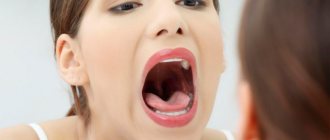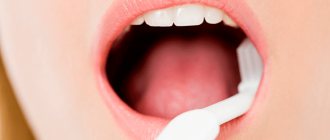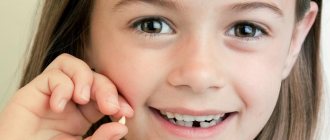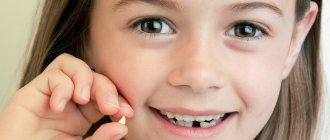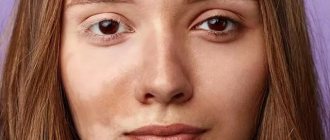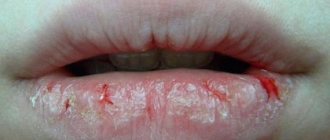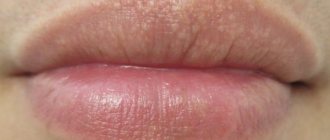Hidden bullhorn is gaining momentum in popularity. The incision is made along the oral mucosa, from the inside, in the place where the nose begins on the back side. Scars are not visible even upon close examination, but it cannot cope with complex imperfections.
There are three types of operations based on objectives.
- Reconstructive (corrects congenital defects or consequences of injuries).
- Anti-aging (fights age-related changes).
- Image (when a person wants to look in accordance with his ideas of beauty).
The hidden bullhorn is preferable for operations of the latter variety. All the features of the procedure are tailored specifically for aesthetic purposes. In this case, it is possible to perform the second function to a certain extent - excess skin is excised with layer-by-layer stitching, due to which wrinkles and ptosis are removed.
Cheilitis
Cheilitis is an inflammation of the red border, mucous membrane and skin of the lips.
In common parlance, the disease is called jamming. The inflammatory process can be long-lasting and periodically worsen. In healthy young people it often goes away on its own, but in children, the elderly and people with chronic diseases it should be treated with medication. Elderly people have a high risk of leukoplakia and malignancy of the process. Cheilitis is treated by a dentist, and if necessary, a therapist, pediatrician and other specialized specialists - an endocrinologist, an infectious disease specialist, etc. - are involved in drawing up a treatment plan.
Clinical researches
Clinical studies have proven the high effectiveness, safety and tolerability of products for daily skin care of adults and children with mild and moderate forms of atopic dermatitis and during remission, accompanied by a decrease in the quality of life of patients. As a result of therapy, a decrease in the activity of the inflammatory process, a decrease in dryness, itching and flaking was noted.
Based on the results of the clinical study, the placement of information on the packaging “Recommended by the St. Petersburg Branch of the Union of Pediatricians of Russia” was agreed upon.
- Ratner Desiri, Avram M.R., Avram M.M., Procedures in Dermatology. Clinical cosmetology, GEOTAR-Media, 2019
- Sukolin Gennady Ivanovich, Illustrated clinical dermatology. Brief alphabetical reference book, publishing house Lux Print, 2010
- Kildiyarova Rita Rafgatovna, Pediatrician for every day. Guide for doctors, GEOTAR-Media, 2021.
Source
Causes of cheilitis
Cheilitis can be an independent disease and a manifestation of other pathologies of the mucous membranes and internal organs. The most common causes of the disease include:
- Dermatoses. The mucous membranes and skin of the lips can be involved in the pathological process in lichen planus, psoriasis, erythematoses and other skin diseases.
- Unfavorable factors. Exposure to hot and cold air, wind, and excessive exposure to UV rays are especially common causes of cheilitis in people who work outdoors and under special weather conditions.
- Allergic reactions. Allergies can be triggered by chemical factors, ultraviolet rays, cosmetics, etc.;
- Other diseases. Secondary cheilitis often develops against the background of atopic dermatitis, eczema, neuritis of the facial nerve, etc.
Natural protective mechanisms are weakened by such factors as hypothermia, previous surgical interventions, long-term antibacterial therapy, hypovitaminosis, etc.
Symptoms and types of disease
Cheilitis on the lips can manifest itself in different ways depending on the form of the disease. Thus, the exfoliative type of inflammation appears more often in women; its main symptom is peeling. The disease is based on neurological and endocrine disorders. Peeling occurs on the red border of the lips and does not affect the skin and mucous membranes. The disease rarely spreads to the entire red border, so part of it remains unchanged.
With severe dry skin, peeling is accompanied by symptoms such as:
- feeling of dry lips;
- burning;
- formation of easily detachable scales.
The disease is long-term and sluggish, with periods of exacerbation occurring from time to time. It rarely goes away on its own. With the exudative form, pain, swelling of the lips, and the formation of large crusts may occur.
Glandular cheilitis develops against the background of the proliferation of minor salivary glands and their subsequent infection. With congenital pathologies, signs of such inflammation of the lips are present in almost all cases. Acquired overgrowth may be associated with chronic diseases of the periodontal tissues, tartar, multiple caries - diseases leading to infection of the dilated ducts. Lesions of the lower lip with this form of cheilitis are more common. The disease develops with the appearance of dry lips, which is initially easy to correct with the help of cosmetics. Subsequently, cracks begin to form, deepen and begin to bleed. The condition is aggravated by the constant desire to lick dry lips - cracks and ulcers can become weeping and become permanent due to the inelasticity of the skin of the lips.
Contact allergic cheilitis develops after exposure to an allergen - an irritant. The most common of them are components of lipsticks and other care products. Allergies can also be associated with bad habits, for example, constantly keeping pencils, pens and other foreign objects in the mouth. Musicians may develop occupational cheilitis due to constant contact of the mouthpieces of wind instruments with their lips. The main symptoms of the disease include:
- severe itching;
- burning;
- swelling of the lips;
- redness of the skin and mucous membranes.
Manifestations intensify upon contact with the allergen. Bubbles of different sizes may form; their spontaneous or accidental opening leads to the formation of ulcers and cracks. Chronic forms of allergic disease are accompanied by peeling, slight itching and the absence of other signs of inflammation.
Actinic cheilitis belongs to the category of diseases that are based on increased sensitivity to weather and other external factors. Usually occurs in response to sun exposure. Exudative forms of this disease are accompanied by the formation of crusts. Sometimes small blisters form, the opening of which leads to painful erosions. In the absence of exudate, the main symptoms are pain, dryness, and burning of the lips. Actinic cheilitis often degenerates into precancerous diseases.
In atopic cheilitis, the main cause of the disease is dermatitis of the same name, or neurodermatitis. It appears in people with an allergic predisposition, and the triggering factor can be medications, cosmetics, food products, as well as microorganisms and their waste products. The disease is accompanied by redness of the lips, itching and peeling of the red border, and damage to the corners of the mouth. After acute symptoms subside, peeling and thickening of the skin may occur. Dryness stimulates the formation of cracks.
IN
In pursuit of youth, most women resort to operations such as a facelift or blepharoplasty, but at the same time they forget about such an important point as the lips and perioral area, which require no less close attention than the rest of the face.
But before we delve into the description of methods and modern approaches to oral rejuvenation, in our opinion, it is necessary to determine its main anatomical components.
Rice. 1. Anatomy of the mouth and perioral area:
1 - skin part of the upper lip; 2 — column of the philtrum (two vertical ridges above the upper lip); 3 - groove of the philtrum; 4 - cupid's bow; 5 - white lip roll - a thin strip of light skin surrounding the red border of the lips on the outside; 6 - tubercle; 7 - commissure - the junction of the lips in the corners of the mouth; 8 - vermillion (red border of lips).
Rice. 2. Muscles surrounding the oral area
The orbicularis oris muscle is formed by muscle bundles located in the thickness of the lips. It begins in the area of the corners of the mouth, where its fibers are woven into the skin at the commissure and surround the lips in the form of a sphincter. The function of this muscle is to close the mouth and pull the lips forward.
The muscle that depresses the angle of the mouth or DAO (Musсulus Depressor Anguli Oris) originates and attaches to the bony edge of the lower jaw, ending in the skin of the commissure of the lips.
The subcutaneous muscle of the neck (M. platizma) covers the entire anterior surface of the neck with a uniform thin layer. M. platizma starts from the clavicle area, is woven into the superficial tissues of the cheek area and at the level of the corner of the mouth (its lateral bundles Lateral Platisma - LP). M. platizma can act as a strong depressor of the lower lip. In some people with well-developed subcutaneous neck muscles, this part of the muscle (LP) may be visible during active movements during chewing, swallowing, and while talking.
It is important to distinguish between the action of the DAO, which pulls the corner of the mouth downwards (Fig. 3a) (vertical traction), and the action of the LP, whose fibers pull the corner of the mouth posteriorly and downwards (posterior oblique traction) (Fig. 3a). Their action is complemented by contraction of the muscle that lowers the lower lip (m. depressor labii inferioris “DLI”). The motor innervation of the DAO comes from the marginal branch of the mandibular nerve (marginalis mandibulae nervus MMN), which projects to the region of the marionette fold (Fig. 2).
Rice.
3. a — action of the DAO muscle; b - action of the lateral part of the platysma (LP) Signs of a young mouth
Signs of a young mouth that the plastic surgeon takes into account when planning and performing anti-aging operations.
Rice. 4. a - schematic representation of a young mouth; b - photo of a young mouth; c - photo of a young mouth smiling
1. Slightly exposed upper teeth. 2. The lower teeth are completely covered by the lower lip. 3. The corners of the mouth are slightly raised. 4. The skin of the upper and lower lips is smooth without vertical wrinkles. 5. Lips are quite full. 6. A clear white lip roll is a thin strip of light skin surrounding the outside of the red border of the lips or the contour of the lips. 7. The grooves of the philtrum are clearly visible - two vertical ridges above the upper lip. 8. The shape of the edges of the lips with artistically expressed anatomical curves. 9. With a harmonious smile, 2/3 of the upper teeth are exposed. The lower lip only slightly exposes the lower teeth.
Signs of an Aging Mouth
Rice. 5. Photo of the mouth of an elderly person: a) with closed lips; b) mouth slightly open
1. The upper lip becomes disproportionately long and completely covers the upper incisors, the red border turns inward and visually decreases. 2. The lower teeth are exposed (Fig. 5, b) when the lips are opened. 3. Gradual drooping of the corners of the lips under the action of the muscle of the same name (DAO) and the appearance of furrows in the corners of the mouth (marionette lines). 4. A fine network of vertical wrinkles appears around the mouth (“purse-string wrinkles”). 5. Lips lose their original volume and become thinner. 6. A clear outline or the so-called white roller disappears. 7. Elongation and flattening of the filtrum occurs. All these signs are associated with loss of elasticity and thinning of the skin, atrophy of the subcutaneous fatty tissue, decreased elasticity of the fibers of the orbicularis oris muscle and the depressor anguli oris muscle, partial resorption of the bones of the facial skull, alveolar processes of the jaws, and malocclusion due to loss of teeth.
Based on the above listed signs, the principles of mouth rejuvenation are determined.
Principles of Oral Rejuvenation
1. It is necessary to raise the mouth as much as possible (oral lifting) in order to cover the lower incisors (midface lift, impact on the mentalis muscle - mentopexy, resection of the muscle that depresses the lower lip, DAO resection, lifting the oral mucosa).
2. Smooth out purse-string wrinkles and even out the skin texture around the mouth (mesotherapy, biorevitalization, peeling, laser resurfacing, Botox injections, filling wrinkles with gel or your own fat).
3. Emphasize the artistic contour of the lips - white rollers (use of gels based on hyaluronic acid, lipofilling of the lip contour, introduction of threads - GORE-TEX or AlloDerm collagen thread, installation of Permalip silicone lip implants, etc.)
4. Restore the volume and elasticity of the lips lost with age (it is very important not to overdo it). It is necessary to ensure that the dynamics of the mouth do not change and at the same time the individuality of each smile is preserved. There should be no distortion of the smile area (for example, the use of fillers or large amounts of fat). Bring to balance the ratio of the upper and lower lips in volume to 1:1.6.
5. Avoid external incisions on the lips, as the resulting scars may subsequently be noticeable and will give the lips an unnatural appearance.
Now let's look at each of the points in more detail.
1. Mouth lift (Stomopexy)
The most famous author of methods for rejuvenating the mouth and perioral area is the American plastic surgeon Dr. W. Little. He was the first to propose performing a mouth lift procedure through small incisions in the mucous membrane. The author called this operation stomopexy. The concept of “stomopexy” includes a whole range of methods, the choice and scope of which depends on the severity of age-related changes in the oral area.
I - Deep midline lifting (SMAS-plasty) leads to raising the corners of the mouth and smoothing the jowls by shortening a group of muscles called modiolus. However, with a vertical rhytidectomy (lifting only the skin of the midface without SMAS), the corners of the mouth are only partially lifted. With any type of facelift, lifting the oral cavity is achieved indirectly.
II - Impact on the mental muscle (mentopexy): Dr. W. Little releases the collection muscle at the base and at the same time lifts the soft tissue block using a special thread passed through a small incision in the oral mucosa in the area of the lower incisors. After this procedure, the contour of the chin is improved, which (instead of the characteristic senile and pointed chin) becomes more rounded. The lower lip moves to a higher position, which allows you to cover the lower teeth, which are already visible with age.
III - Resection (release) of the muscle that depresses the lower lip (DLI-release): during lifting of the chin, the detachment can be extended in any direction. This releases the muscle that lowers the lower lip (m. depressor labii inferioris). This maneuver was first proposed by French plastic surgeon Christian Marinetti in 1999.
IV – Lifting of the oral mucosa: Dr. Little typically excises a narrow triangle of oral mucosa above and just lateral to the corner of the mouth. When stitching the triangle, the corners of the mouth rise slightly. The small scars that remain after this procedure are located inside the mouth on the mucous membrane and only a dentist can notice them upon careful examination. All incisions are sutured with a thin absorbable thread.
V - Auxiliary suture for the commissure of the mouth: passes in the form of a loop in the subcutaneous layer and is attached to the deep dense tissues at the base of the nostril of the corresponding side of the mouth. For this, a special non-absorbable thread (tissulift) is used. This procedure is rarely used (according to the author, in less than 5% of cases).
VI - Resection of DAO (m. Depressor Anguli Oris - muscle that lowers the corners of the mouth) is performed to adequately raise the corners of the mouth. Dr. Little combines a facelift with transection of the depressor anguli oris muscle in almost all of its patients. The DAO resection procedure was first described by French plastic surgeon Claude LeLouarn.
How is the DAO resection procedure performed?
Preoperative markings are performed with the patient in an upright position. The projection of the muscle depressing the corners of the mouth is 1 cm lateral (outward) and 1 cm below the commissure of the angle of the mouth. A horizontal line is drawn in the upper quarter of the puppet's fold parallel to the lower lip. Under local anesthesia, an injection needle is inserted percutaneously and the future incision is marked on the buccal mucosa (Fig. 6).
Rice. 6. Scheme of preoperative marking of the operation “resection of DAO”.
A special instrument is used to move the horizontal fibers of the buccal muscle apart.
Then we reach the deeper vertical fibers of DAO.
At this stage it is important to see the lateral (outer) edge of the DAO. The muscle is isolated and, under visual control, divided to the level of subcutaneous fat. Several absorbable sutures are placed on the mucosa.
At the end of the procedure, it is very important to fill the area of retraction formed after muscle separation with your own fat. Dr. Little showed that a single resection of the DAO during a facelift produces durable long-term results.
Rice. 7. DAO resection with lipofilling (photo of patient A., 56 years old)
This is not a public offer! There are contraindications. Before use, consultation with a specialist is required.
Rice. 8. DAO resection with lipofilling (photo of patient B., 32 years old, “before and after” at rest) – the corners of the mouth after the operation are involuntarily slightly raised.
This is not a public offer! There are contraindications. Before use, consultation with a specialist is required.
Rice. 9. Photo of patient B. with muscle tension: “before” - the corners of the mouth are lowered; “after” DAO resection – the patient is unable to voluntarily lower the corners of her mouth (the chin muscles remain intact).
This is not a public offer! There are contraindications. Before use, consultation with a specialist is required.
2. Improving the relief and structure of the skin around the mouth
In order to improve the condition of the skin around the mouth and remove fine wrinkles, it is necessary to use various cosmetic techniques. You can improve the condition of the skin around the lips in various ways, and only a competent cosmetologist will be able to choose exactly the technique that is most effective in each specific case.
A . Biorevitalization and mesotherapy will help qualitatively improve the condition of the skin around the mouth. Both of these techniques have a deep and long-lasting moisturizing effect. As a result, the skin is smoothed, filled with moisture, becomes velvety and acquires a healthy color. Both methods are aimed at rejuvenating the skin: increasing turgor and elasticity, smoothing out fine wrinkles, as well as moisturizing. Biorevitalization involves the use of low concentration hyaluronic acid and gives an instant, but less lasting saturation effect. The result of mesotherapy cocktails containing vitamins, microelements, collagen, elastin, coenzymes, etc. manifests itself more slowly, but produces more lasting changes, also preventing skin aging.
B. Peels and Botox are aimed at smoothing the skin texture and smoothing out wrinkles. Any peelings (physical (laser or mechanical polishing) and chemical (glycolic, retinol and many others)) significantly affect the condition of the skin around the mouth: they increase blood supply, stimulate cell renewal and, thereby, even out the relief, resulting in smoothing out fine wrinkles, deep wrinkles will become almost invisible, and new purse-string wrinkles will not appear for a long time. After peeling, the skin will look even, smooth, and young. Botox injections, by blocking nerve endings and excluding some groups of facial muscles from active facial expressions, will also help smooth out purse-string wrinkles above the upper lip and lift the corners of the mouth.
B. Contour plastic surgery of lips and deep wrinkles. To obtain a more vibrant effect, it is necessary to fill the lips, which over time lose their youthful plumpness. This can be done using hyaluronic acid fillers or lipofilling. (These techniques will be described in more detail below).
3. Lip contour correction
To make lips look more expressive, American plastic surgeons have proposed the “Parisian lips” procedure. Its essence lies in the fact that it is necessary to emphasize the contour or white ridge of the lips, which flattens with age and loses its expressiveness. You can strengthen the lip contour using fillers based on hyaluronic acid (Uvederm ultra, Restylane, Sugiderm, etc.). The gel is injected into the problem area, taking into account the patient’s wishes. Some people prefer to enhance the cupid's bow area, while others want to highlight the sides of the upper lip. In certain cases, amplification of the filtrum columns is indicated. At the same time, the natural contour of the lips is recreated, their natural youth is restored. Unfortunately, the procedure will need to be repeated once a year.
To create an even and clear contour of the lips, in addition to injection methods, you can also use surgical correction methods: in particular, synthetic GORE-TEX thread or collagen thread - AlloDerm. Threading provides lasting long-term results. For example, the AlloDerm thread is replaced by its own collagen over several months without loss of volume. In recent years, the Permalip silicone implant has been widely used in the United States to restore lip contour and volume.
4. Restoring lip volume
Rice. 10. Scheme of lip lipofilling (explanation in the text)
In addition to smoothing the contour, with age the lips lose their original volume and become thinner. Restoring lip volume can be done using gels based on hyaluronic acid or lipofilling. Lip contouring with hyaluronic acid gives an immediate enlargement effect, but is not very durable - for a maximum of 1 year. Injections of your own fat for lip augmentation and smoothing of deep wrinkles are characterized by 2-3 weeks of postoperative swelling, but, at the same time, a more natural shape, consistency, beautiful, bright lip color, as well as a permanent result. It is important to note that when performing lipofilling, the lips should not take the shape of a tube. Fat must be introduced according to certain rules. The upper lip must be filled along the contour and in the form of “balls” in the central part and on the sides of it. The lower one - strictly along the contour and on both sides of the center line in the form of “balls” (Fig. 10). Let's also not forget about the fine wrinkles around the mouth. They also need to be filled with your own fat.
Many patients initially enlarge their lips (fill out wrinkles) with hyaluronic acid fillers, and if they like the effect, they fix it by performing lipofilling.
All of the above procedures must be performed in such a way that the dynamics of the mouth do not change and the individuality of each smile remains (Fig. 11). There should be no distortion of the smile area (for example, due to the use of fillers or large amounts of fat).
Rice. 11. Patient “before and after” DAO resection, lip lipofilling, intradermal fat filling of purse string wrinkles, nasolabial furrows and marionette lines.
This is not a public offer! There are contraindications. Before use, consultation with a specialist is required.
In addition to filling, VY lip surgery provides a stable increase in lip volume. The VY technique helps to increase the volume and height of the red portion of the lip by “turning” the inner (wet) surface of the lip outward. During the operation, several V-shaped incisions are made on the inner surface of the mucous membrane of the upper or lower lip, which are then sutured with an absorbable thread in the shape of a Y. This manipulation “pushes” the lips outward and gives them volume (Fig. 12).
Rice. 12. Scheme of the VY plastic surgery
Fig. 13. Photo of patient S., 27 years old, before and after VY plastic surgery of the upper lip
This is not a public offer! There are contraindications. Before use, consultation with a specialist is required.
With age, lips not only lose their volume, but also the skin part of the upper lip lengthens. This involves removing a narrow strip of skin right under the base of the nose in the form of a wavy strip, tapering at the edges, resembling the pattern of buffalo horns. This is why this technique received the name “bull’s horn” in English. After excision of the skin, the edges of the wound are sutured. After 3-6 months, the postoperative scar fades and becomes almost invisible. As a result of the operation, the red border of the lips is raised and slightly “turned out”, the upper lip becomes wider, and the upper teeth are slightly exposed (Fig. 14).
Rice. 14. Scheme of the bullhorn operation.
Thread suspensions (lip suspension) are indicated for patients who want to slightly raise the upper lip, slightly reduce the distance of the skin part of the upper lip, and emphasize the columns of the filtrum. Threads are passed through mini-incisions inside the nose using a special technique and the upper lip is lifted (Fig. 15).
Rice. 15. Scheme of the “Lip suspension” procedure.
Rice. 16. Patient D, 32 years old. “Before and after” photos of VY plastic surgery and lip suspension procedure of the upper lip to shorten its skin part.
This is not a public offer! There are contraindications. Before use, consultation with a specialist is required.
In this part of our article, the technical aspects of performing certain procedures related to rejuvenation of the mouth and perioral area were discussed in detail. However, to choose the most optimal method for correcting age-related changes, it is necessary to have a theoretical understanding of the causes, mechanisms and stages of their occurrence. To date, the most significant contribution to the development of the theory of facial aging has been made by the concepts of B. Mendelson (spaces, ligaments, resorption of bones of the facial skull), S. Coleman (facial lipoatrophy) and others. However, in our opinion, the mechanisms of aging and methods for correcting age-related changes in the perioral area are most fully reflected by the concept of Claude LeLouarn called “Face Recurve” or “Facial Restoration”. This is exactly what will be discussed in the second part of our article.
The concept of “Face Recurve” in rejuvenation of the perioral area
In 2006, famous French plastic surgeons Claude LeLouarn and Jacqees Buis developed their original concept of “Face Recurve”. The development of this revolutionary concept was based on new ideas about the mechanisms, principles, and stages of facial aging, on the basis of which the approach to rejuvenation of the face and the perioral area in particular was radically changed. According to Claude LeLouarn and Jacqees Buis, the formation of clinical signs of an aged face takes place in 2 stages (stages): stage 1 - “cutaneous” (superficial) and stage 2 - “structural” (deep).
1 stage - “skin aging”. Includes changes that occur over time on the outer “shell” of the human body, that is, the skin. This manifests itself in the loss of elasticity, firmness of the skin, its thinning, enlarged pores, the appearance of age spots or, conversely, areas of depigmentation, fine wrinkles, etc.
2 stage - “structural aging”. Affects deeper layers: adipose tissue (lipoatrophy), muscular-fascial system, bone tissue (resorption). Clinically, this manifests itself in the form of flattening of the middle zone of the face, deepening of the nasolacrimal (dark circles under the eyes) and nasolabial furrows, folds of grief, the appearance of bags under the eyes (fat “hernias”), jowls, etc. And further progression of this process leads to sagging facial tissues (ptosis).
According to the “Face Recurve” concept, facial aging develops mainly under the influence of constant contraction of certain facial muscles. These muscles initially have a curved shape and in young people are located in the deep fat layer. Over time, facial muscles straighten and shorten. These changes in the shape of the facial muscles of Claude LeLouarn and Jacqees Buis were confirmed by x-ray studies.
Under the action of muscle contraction, the underlying fat is pushed out more superficially. Thus, grooves are formed (underneath them lies a “tight”, straightened muscle), surrounded by excess fat along the periphery. This is how circles under the eyes, uneven cheekbones, “sorrow” folds and sagging cheeks, as well as vertical folds on the neck are formed.
According to the authors, during the aging process of the face, gravity is only of secondary importance in those areas that are most susceptible to repeated contractions of facial muscles. Some bundles of these muscles are peculiar age markers (signs) and are responsible for the formation, for example, marionette folds (similar to the “folds of grief”), medial fibers of the neck muscle (m.platizma), nasolabial fold, etc.
On a young face, the facial muscles are elongated, curved and relaxed at rest. Only when these muscles are tense can signs of future markers of aging be seen. During the aging process, age markers (deep nasolabial fold, folds of grief, medullary cords of the neck, etc.) are clearly defined even in the absence of facial expressions.
Based on their findings, Claude LeLouarn and Jacqees Buis developed the “Face Recurve” technology, which involves timely impact on certain groups of facial muscles, as well as the correction of deep fat layers. In addition to a new approach to facial rejuvenation, the authors proposed a whole range of new cosmetic and surgical procedures aimed at preventing and correcting age-related changes in the face. French surgeons were the first to propose a certain algorithm of actions depending on the age and condition of the patient’s face. According to the concept of facial aging, this algorithm is divided into several stages, each of which corresponds to a specific set of preventive and therapeutic measures.
In the opinion of the authors of this article, the theory of aging and, accordingly, the principle of facial rejuvenation “Face Recurve” are most applicable in rejuvenating the mouth and perioral area. Judge for yourself.
Depending on age, Claude LeLouarn and Jacqees Buis propose to divide “facial aging” into several stages and, according to this “division,” carry out preventive and therapeutic measures.
Stages of rejuvenation of the perioral area
A. Preventive stage
- “Toxin recurving”
At the age of 20-25 years, the introduction of Botox prevents a gradual increase in muscle tone at rest and delays the appearance of signs of aging. Precisely measured doses of botulinum toxin injections are administered into the DAO muscle. The injection of the drug should be as close as possible to the motor nerve of this muscle. If the injection is made 5 mm beyond the projection of the nerve, the effectiveness is reduced by 50%.
B. Stage I of aging - “Botulinum Toxin-Filler Recurve”
At the age of 30-35 years, the “Botulinum Toxin-Filler Recurve” technology is offered.
Injections of Botox, which affects both muscle tone at rest and the strength of contraction, are complemented by the introduction of hyaluronic acid filler into those areas where the formation of recesses begins. The filler is injected deep under the muscle to return it to its original convexity. Experience shows that the effect of DAO blocking is often offset by LP reduction. Therefore, it is necessary to inject Botox into the LP fibers (lateral part of the platysma). Rice.
17. Botox injection points into the LP muscle bundles. B. II stage of aging.
Facial restoration - “Face Recurve”. For patients aged 40-45 years, surgical dissection of the DAO as well as the lateral portions of the platysma muscle (lateral part of the platysma - “LP”) is indicated. The operation is performed under local anesthesia. In this case, the depressed area after DAO resection and marionette wrinkles are necessarily filled using lipofilling.
D. III stage of aging
Facial restoration using lifting - Face Recurve Lift. For patients 50 years of age and older, treatment includes tightening and excision of excess facial skin with DAO resection and lipofilling. It seems like a lot of effort is needed to achieve one goal - mouth rejuvenation. Fortunately, each method is simple and quick to perform, and all incisions and scars remain invisible. And it takes very little time to show how much the perioral area will improve, deep and small creases will go away, and the lips will return to their former fullness and seductiveness. And most importantly: all these changes will look absolutely natural. It is important to note that all these techniques can be used for facial beauty - improving the shape, volume of the lips and perioral area at any age.
To communicate with patients who have undergone facial rejuvenation, come to our forum, section Anti-aging surgeries
Diagnostic features
If inflammation appears on the lip, it is advisable to visit a therapist, for children a pediatrician, if indicated, an infectious disease specialist, a dentist, or other specialized specialists. Diagnosing cheilitis is usually not difficult - a specialist will conduct an examination, listen to complaints and prescribe a series of tests. If the allergic nature of the disease is suspected, allergy tests may be recommended, and if plaque appears, it is advisable to take a scraping. To detect endocrine and other disorders that may cause the disease, biochemical blood tests and other diagnostic methods are often prescribed. In rare cases, a biopsy is required to differentiate cheilitis from other pathologies. This will help to exclude the malignant or precancerous nature of inflammatory formations and prescribe the correct treatment.
Treatment methods
The treatment plan for cheilitis is developed individually, depending on the form of the disease, the severity of symptoms, and the characteristics of the health condition. Thus, in the treatment of the exfoliative form of the disease, the key element of effective treatment is the impact on the psycho-emotional sphere: you will need to contact a neurologist or psychoneurologist to prescribe sedatives and antidepressants according to indications. Consultation with an endocrinologist may be required.
Local treatment may involve the use of laser or ultrasound physiotherapy, local anti-inflammatory drugs, and less commonly, radiation therapy. Elimination of excessive dryness is possible with the help of hygienic lipsticks. To speed up recovery, the doctor may prescribe vitamin therapy, UVOC and other methods of maintaining the body's defenses.
Therapy for glandular cheilitis consists of using local anti-inflammatory agents. Antibacterial, antiviral, and hormonal ointments can be used. A radical method of therapy is electrocoagulation of the salivary glands or their surgical removal, as well as laser ablation. These methods are used when conservative methods are ineffective. After the main course, the doctor will prescribe medications to prevent relapses - they will eliminate dry or weeping skin. It is important to sanitize the oral cavity in a timely manner and undergo professional teeth cleaning.
Treatment of atopic cheilitis consists of eliminating irritating factors. Drugs with antipruritic and anti-inflammatory effects can be used locally, and therapy with antihistamines with a systemic effect is also carried out. The use of glucocorticosteroids allows you to get quick relief, but it is important to strictly adhere to medical prescriptions - they can only be used for a short time. It is important to follow a hypoallergenic diet and remove allergenic foods from the diet.
Therapy for meteorological cheilitis begins with limiting harmful effects, for example, insolation. Local treatment is usually carried out - the doctor prescribes hormonal agents and protective creams, including those with SPF. The course of treatment is supplemented with vitamins - vitamin-mineral complexes or individual preparations (B, PP, C, etc.).
In the treatment of macrocheilitis, immunocorrective and antiviral therapy is of particular importance. The doctor may prescribe:
- hormonal anti-inflammatory drugs of systemic action;
- novocaine blockades;
- antihistamines, etc.
Laser therapy can have a positive effect on the correction of the entire triad of symptoms. Other physical therapy methods have been successful in treating facial neuritis.
Possible complications
Failure to see a doctor in a timely manner often causes serious complications. The disease itself often does not pose a serious health risk. But only an experienced specialist can tell you how to treat cheilitis. Self-medication can lead to unpleasant consequences and provoke the occurrence of a chronic form of the disease. In addition, cheilitis is dangerous because its symptoms can mask malignant tumor processes. It is important to remember that some forms are prone to malignancy - cheilitis may be followed by precancerous conditions.
Perioral dermatitis
All iLive content is reviewed by medical experts to ensure it is as accurate and factual as possible.
We have strict sourcing guidelines and only link to reputable sites, academic research institutions and, where possible, proven medical studies. Please note that the numbers in parentheses ([1], [2], etc.) are clickable links to such studies.
If you believe that any of our content is inaccurate, out of date, or otherwise questionable, please select it and press Ctrl + Enter.
Perioral dermatitis (syn. rosacea-like dermatitis) is considered by some authors to be a separate nosological entity, while others consider this dermatosis as a type of rosacea or seboreids.
[1], [2], [3], [4], [5], [6], [7]
Pathomorphology
The skin shows a moderately pronounced picture of subacute dermatitis with perivascular and perifollicular infiltrates containing a large number of neutrophilic granulocytes. Sometimes accumulations of epithelioid cells with the presence of giant forms are detected.
The histogenesis of dermatitis is unclear. Some authors attach importance in its development to the increased sensitivity to sunlight of persons suffering from seborrhea, the effect of fluoride-containing drugs, especially fluorinated corticosteroid ointments.
Symptoms of perioral dermatitis
Perioral dermatitis develops predominantly in young women. The rashes are located around the mouth, on the chin and nasolabial folds, on the cheeks and less frequently periorbitally - in the eyelid area, on the cheeks in the form of erythematous spots, flat cone-shaped papules or papulo-vesicles and papulo-pustules. The rash is located symmetrically, consists of many small papules, sometimes papulovesicles, partly acne-like. The red border of the lips is not affected; a light strip of unaffected skin remains at its border with the skin, which is considered characteristic of this dermatosis. The rashes are covered with crusts. They are often located in groups. A characteristic sign is the presence of a narrow strip around the mouth, free from rashes. Subjective sensations are usually insignificant: mild itching, sometimes burning. The course of the disease is long, remissions are usually short-lived (unless the cause of the disease is eliminated).
Source
Irritation in the corners of the lips - what to do about the “stubs”?
Last update: 03/03/2021
Painful cracks in the corners of the lips are familiar to everyone from early childhood. Unfortunately, this trouble does not go away over the years, like childhood allergies to oranges and chocolate. The skin at the site of irritation may be very dry or weeping, bright red or covered with a white crust. One way or another, eating causes a lot of unpleasant sensations: it’s impossible to open your mouth due to pain, any contact with sour and salty foods becomes torture. Sometimes it hurts to even talk, and looking in the mirror, you just don’t want to leave the house.
Irritation around the mouth (adults)
The skin is a kind of indicator of the condition of the body . Any health problems are immediately reflected in the condition of the skin in the form of discoloration, redness, and rashes. The epidermis around the lips is considered especially sensitive - it is this area that is more susceptible to peeling and all kinds of inflammation than other areas of the body. Lips and the skin around them require special care , since the upper layers of cells dry out quickly, and the production of sebum in this area is minimal.
What to do if the corners of your lips are cracked
Among all kinds of ailments and ailments, there are some that we do not take seriously. For example, we often ignore periodically occurring bumps in the corners of our lips, naively believing that their intrusion into our everyday life is not fraught with serious consequences. What justifies such a frivolous attitude to the problem, and why the skin in the corners of the lips cracks, we will try to find out today.
Why does irritation occur?
Redness and spots around the mouth
- The delicate skin around the mouth quickly reacts to changes in the external environment and various internal problems , manifesting itself in irritation, redness and peeling;
- expired cosmetics and hygiene products ;
- The use of drying masks for those with excessively dry skin;
- Irritation around the lips may result from overexposure to ultraviolet rays ;
- Increased androgen levels during adolescence lead to dry skin and red spots;
- Rashes and redness can be a signal of a malfunction of the immune system ;
- Climate change;
- The reaction to long-term treatment and hormonal medications (birth control) causes irritation around the mouth area.
Cream "La-Cri" against irritation in the corners of the lips
La-Cri cosmetics are created specifically to combat skin irritation in both children from 0 months and adults. The cream is suitable for combating mild seizures, as well as for prevention and skin care.
The cream is based on extracts of natural components that have a gentle effect on the skin and do not cause an allergic reaction.
- Serena and licorice soothe inflammation and relieve flaking.
- Violet and bisabolol also have anti-inflammatory and soothing effects.
- Avocado and panthenol soften the skin and help it recover.
- Walnut protects the skin from germs and promotes healing.
Diseases
Diagnosis of many diseases begins with an examination of the skin around the mouth - inflammation and other defects often indicate the presence of serious diseases :
- Allergy. If the irritation is the result of an allergy, then small affected areas can be cured within a week. To do this, it is enough to identify the cause of the defect and eliminate it.
- Food poisoning.
- Kidney and liver diseases.
- Intestinal microflora disorders.
- Cardiovascular diseases.
- Nervous system disorders and depressive states.
- Hormonal disorders.
- Skin diseases: dermatitis, psoriasis, streptoderma.
What measures to take
Treatment of irritation around the lips involves identifying the factor that caused the defect and eliminating it . Influencing only the visible sign of the disease will not give positive results. A competent approach to eliminating the problem that has arisen includes several main steps .
- In order to most accurately determine the cause of irritation, you need to temporarily stop using decorative cosmetics , creams, toothpastes containing strong fragrances. In addition, you should stop using medications for external use - ointments, gels, etc.
- Once the cause has been determined, treatment can begin. Depending on the type of irritation (peeling, inflammation, rash), appropriate measures are necessary. Thus, peeling can be eliminated with gentle peeling and intensive moisturizing.
- Allergic reactions of various origins can be successfully treated with antihistamines. The most commonly used drugs are in the form of ointments and medications for internal use.
- Inflammation and redness can be neutralized with the help of lotions from decoctions of medicinal herbs (chamomile, sage, immortelle). This will help relieve slight swelling and relieve irritation. However, this method will not be very effective in the presence of large rashes.
- In parallel with other treatment methods, it is recommended to take general strengthening vitamin complexes , which contain Ascorutin and vitamin B6. If the irritation is advanced, your doctor may prescribe antibiotic treatment.
- Throughout the entire course of treatment, you need to protect the skin around the lips from direct sunlight ; prolonged exposure to the sun is contraindicated.
Photo 2: During treatment, you should reconsider your diet: limit the consumption of smoked meats, chocolate, citrus fruits, and alcohol. The diet should contain a large amount of fiber in the form of fresh vegetables and fruits, and you need to drink enough water. Source: flickr (sathish mrb).
Pathogens
Irritation in the corners of the lips even has a scientific name - angulitis. There are two subtypes of angulitis - depending on the causative agents of irritation.
- Streptococci. These are bacteria of several types that cause a wide range of inflammatory diseases - from scarlet fever to meningitis. Children are most susceptible to streptococcal infections.
- Yeast-like fungi Candida. In fact, such a fungus is constantly present in our body. But when immunity decreases, its cells begin to multiply many times. As a result, inflammation and whitish discharge appear.
Homeopathic treatment for irritation
Homeopathy has in its arsenal many drugs used to eliminate various defects of the epidermis. The selection and prescription of the remedy should be carried out by a homeopathic physician , since the effectiveness of treatment directly depends on the constitutional type of the patient and the symptoms present.
The list of the most commonly used drugs is as follows:
- Arsenicum album. Prescribed for severe peeling of the lips and the area around them. Prescribed for thin, fair-haired people prone to respiratory diseases;
- Petroleum. The drug helps moisturize and soften the skin , suitable for anxious people who often complain of itching and irritation of the skin;
- Graphites. The drug is prescribed if skin problems are the result of a disease of the cardiovascular system , it helps smooth the walls of veins and blood vessels, and improves blood circulation. Constitutional type - people with excess weight and pale skin;
- Mezereum. The product will help cope with irritation caused by nervousness . In patients prescribed the drug, manifestations of conjunctivitis can often be observed;
- Sulfur. Helps cope with inflammation around the lips associated with disorders of the gastrointestinal tract . Most often prescribed to hypochondriacs with a hot temper and constant hunger;
- Silicea. Actively fights rashes and blisters around the mouth, accelerates the healing of ulcers . Suitable for people with flabby muscles, irritability, and often complaining of excessive sweating of the feet.
Source
What to do
Regardless of the cause, treatment for cracked corners of the lips can be carried out using both traditional medicine and folk remedies. However, why and how to treat if the corners of the lips are cracked is best entrusted to modern medicine or cosmeceuticals - science located at the intersection of medicine and cosmetology. When the lips crack in the corners of the mouth, treatment at home with herbal infusions and lotions based on vegetable fats can bring only minor short-term relief of symptoms.
The best treatment is prevention
Good means of prevention are products with panthenol. EVO Panthenol hygienic lipstick, containing the well-known dexpanthenol, will help reduce the risk of seizures and get rid of discomfort. It promotes intensive lip restoration, accelerates regeneration and healing, and also effectively normalizes the protective functions of the skin in the corners of the mouth. Cocoa butter and shea butter restore the elasticity of the delicate skin of the lips, and vitamin E protects the skin from adverse environmental influences. If you remember its existence from time to time during the day, then relapses of seizures can be significantly prevented.
For more complex cases and additional protection in cases where seizures have already appeared, it is recommended to apply Universal Cream Panthenol EVO 5% to problem areas. It contains panthenol in optimal quantities, which will help cope with the problem as quickly as possible.
Source
